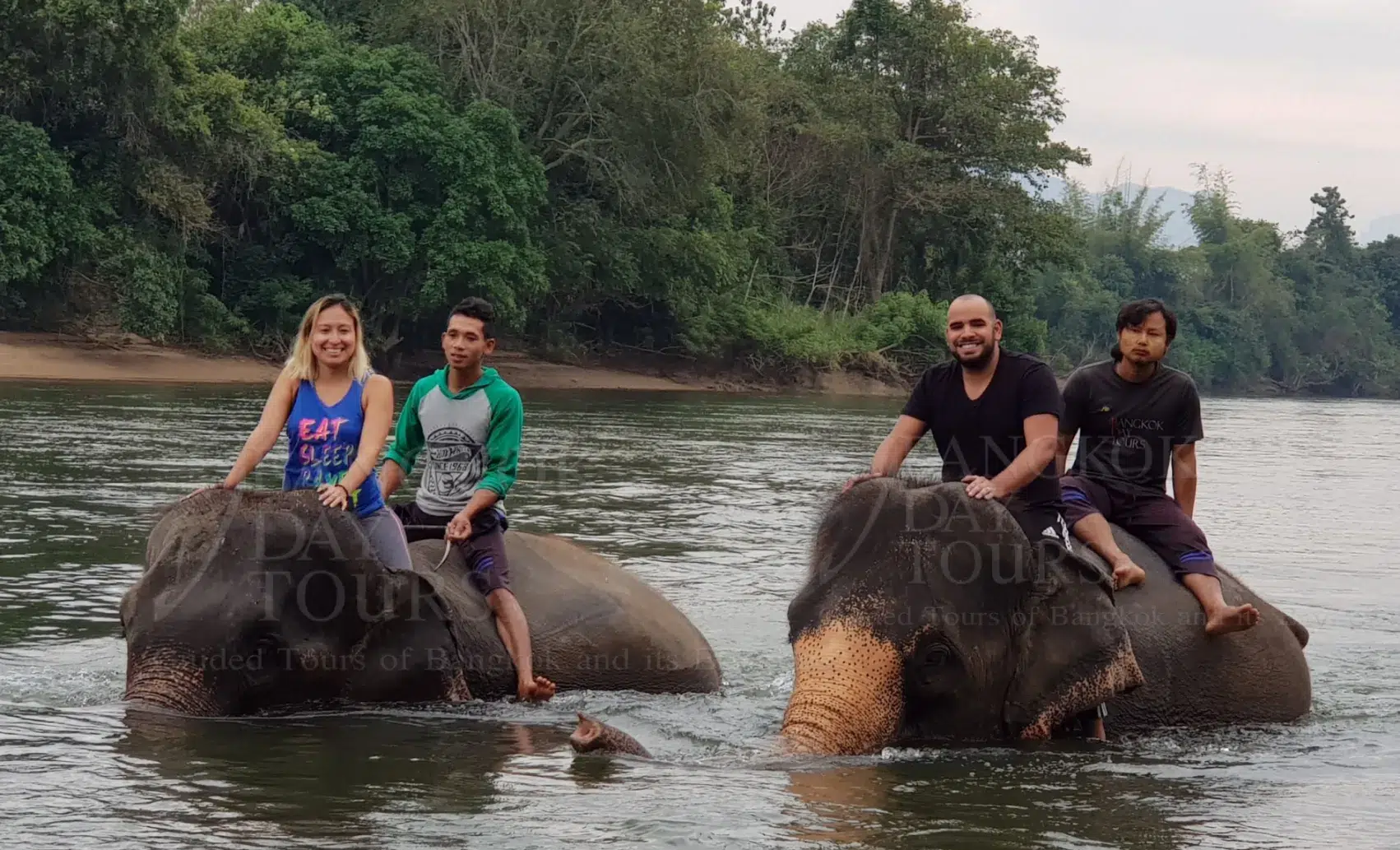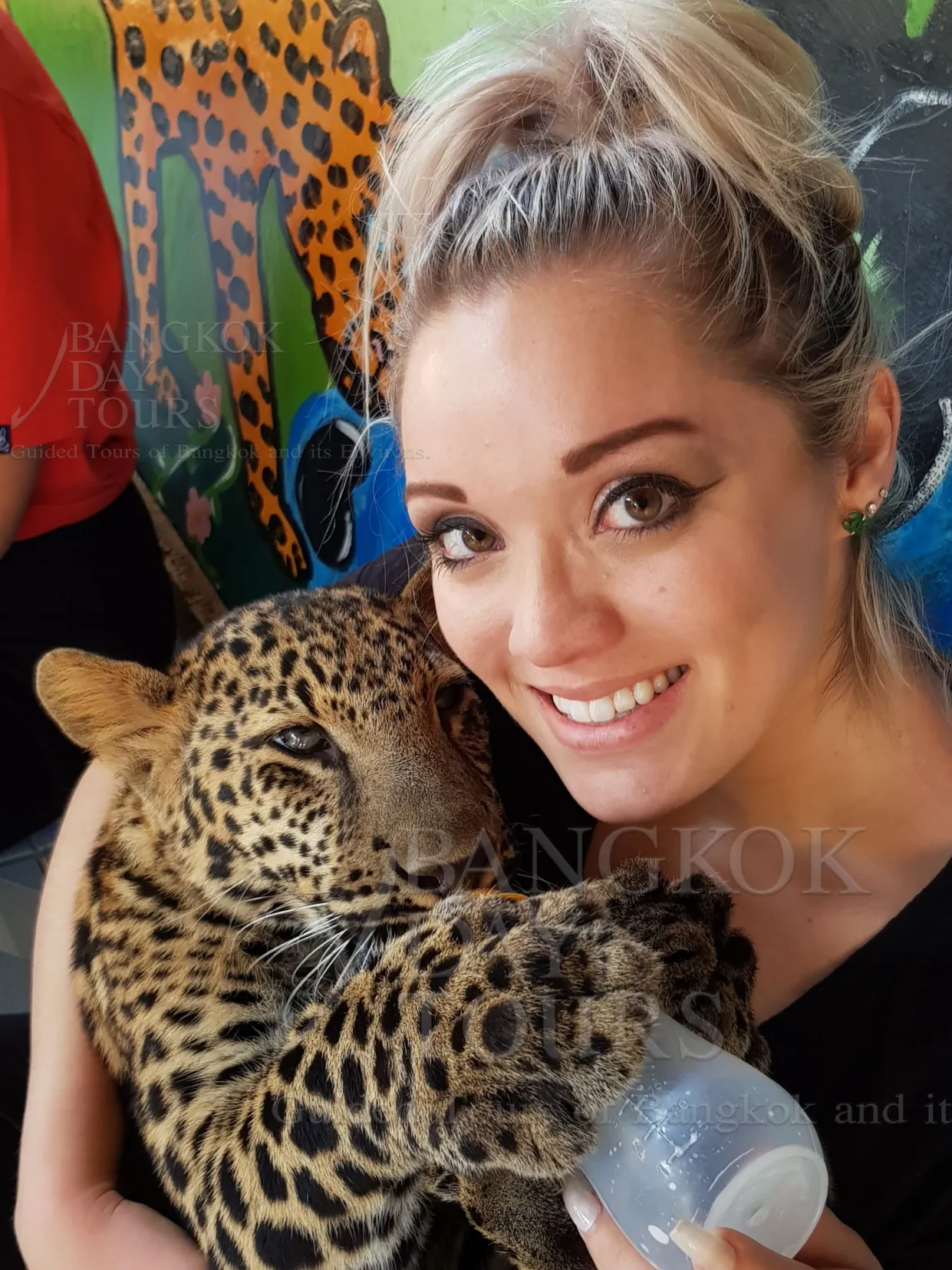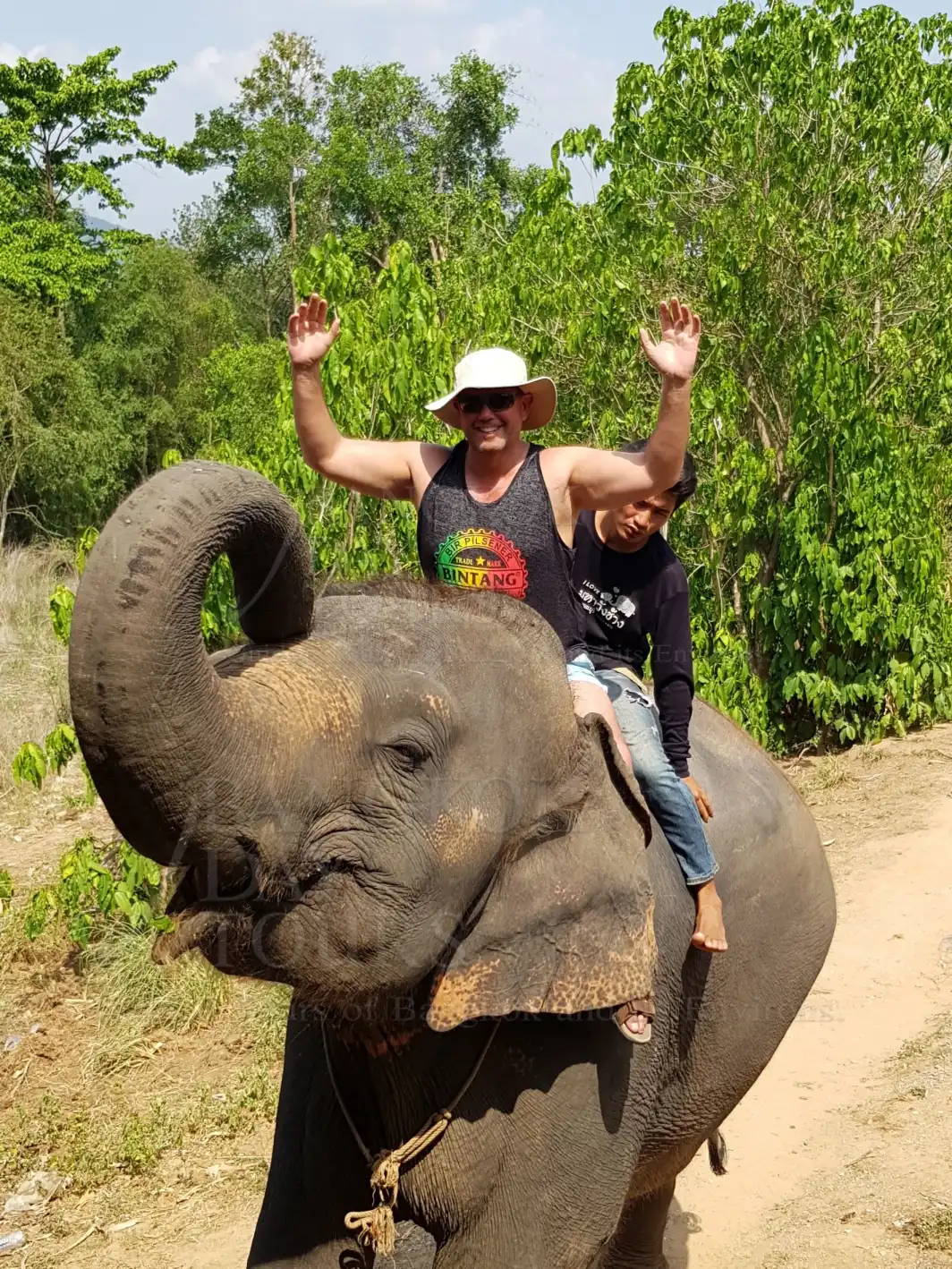Attractions information
Ampawa Village
Ampawa is a district in Samut Songkram province, which is only an hour and a half from Bangkok.
Although it is the smallest of the 76 provinces in Thailand, it has an amazing network of 330 canals and on Saturday and Sundays has its own Floating Market in the evenings.
In Ampawa many pleasant Thai families have opened their homes so that visitors can get a glimpse of their enviable lifestyle. Homestays cater for romantic couples, small groups of friends and large groups of students, with accommodation to suit.
The best way to get around Ampawa is to walk and there are many picturesque lanes which run along the canals. Teakwood homes are built on stilts and inside, you'll find these homes in immaculate condition.
The night-time boat trip on the Mae Klong River lets you enter the enchanting world of fireflies swarming in the trees along the river bank. It's an unbelievable sight, as entire trees are aglow with flashing yellow lights.
A visit to the temple at Wat Bangkae Noi is a must because the interior walls & ceiling of the main chapel have intricate teakwood carvings and time spent here will leave you in awe of the fine craftsmanship found in these carvings.
Ampawa is famous for its TaoTan Palm Sugar and also for the hand-painted porcelain crockery called Benjarong.
Attractions information
Benjarong Porcelain
Benjarong is exquisite crockery made from clear-glazed porcelain and hand painted in traditional patterns by Thai artists.
Benjarong means 'five colors' with each piece crafted from clay, fired in a charcoal oven, then hand painted with any or all of the five colors in 18th Century tradition.
The Benjarong ceramics of Ampawa are precious works of art, created through devotion, long practice and the ability of a community to come together to create genuine delicate, traditional Benjarong porcelain.
Popular among Thai royalty and the elite classes for their domestic use from the ancient Ayudhaya period to the early twentieth century, Benjarong was initially produced in China for the Thai royal court according to Thai designs. But later Thai craftsmen were able to produce Benjarong pottery by themselves.
Benjarong reached its zenith during the reigns of King Rama II - King Rama V, when an almost endless number of exquisite designs were developed and produced, many of which are now highly treasured.
These days, Benjarong porcelain of Samut Songkhram is often been as a gift for participants at national and international events. For example, Ban Phinsuwan Benjarong, produced beautiful mementos for the world leaders attending the 2004 APEC meeting hosted by Thailand.
Attractions information
Thai Massage
Thailand has a doubtful reputation regarding its liberal interpretation of a 'massage', but a genuine Thai massage is one of the must-do aspects of your visit here.
Traditional Thai Massage, which is based on a holistic vision of health, uses a variety of techniques including yoga and meditation.
Traditional Thai Massage is characterised by three main elements:
First, stretching exercises for dynamic and fluid, in a back and forth continuous rhythm, these exercises are generally based on yoga postures, but no prior knowledge of this discipline is required.
Secondly, the Thai massage has an energy at work, which is to perform exercises, massage and put pressure on specific regions or specific points along the energy lines of the body, which are similar to acupuncture meridians. The therapist exerts pressure with the palms, finger, arms, forearms, elbows and feet.
Thirdly, each massage is conducted with an attitude of meditation and contemplation. Accordingly, manipulation, stretching exercises and special attention to breathing promote blood circulation, help to relieve muscle tension and energy blockages and restore the body flexibility and mobility.
The effect of a relaxing Thai massage soothes the mind and induces a state of general well-being, both physical and spiritual.
Attractions information
Fireflies in Ampawa
The night-time boat trip on the Mae Klong River provides the opportunity to enter the enchanting world of the fireflies as they swarm in the Lampu trees along the river bank.
It's an unbelievable sight as entire trees are aglow with flashing yellow lights. Thailand has over 100 species of firefly.
The firefly is an insect which is particularly known for its characteristic luminescence. It has special abdominal organs, which cause a chemical reaction with the organic synthesis of an enzyme called luciferasi.
The fireflies at Ampawa are unique in that they flash synchronously with each other. Fireflies use the flashing light to find and communicate with potential mates.
While most North American firefly species are rovers, twinkling in the characteristic patterns of their species as they fly, Ampawa's fireflies flash in unison creating a spectacular communal display for their mates, akin to a Christmas tree all alight.
Males of the Pteroptyx genus congregate in the lampu trees near water and flash rhythmically for several hours per night. In cycles lasting several seconds, "firefly trees" appear at first completely dark until all of the constituent fireflies light up simultaneously. Often, the same tree acts as a locus for such congregations for several nights consecutively. This is unforgettable.

Attractions information
Floating Market Damnoen Saduak
Waterways have always been an integral part of Thai life and many communities depended entirely on them for their daily existence.
Long before cars, boats of all shapes and sizes plied the rivers and canals through the kingdom of Thailand, trading their wares and delivering their supplies.
The Floating Market at Damnoen Saduak is located in Ratchaburi Province which is just over 100 kms or two hours drive from the capital city of Bangkok.
This is a particularly fertile area, being irrigated by a 32 kilometre straight-line canal constructed by King Rama IV way back in 1866.
It connects the Taachin River with the Mae Klong River and became a major transport artery between the provinces of Samut Sakorn and Samut Songkram.
Apart from providing transportation, Damnoen Saduak Canal also provides year-round water, with more than 200 small canals having been dug by farmers to irrigate their land.
The area is famous for the quality of its fruit, namely grapes, mangoes, bananas, oranges, papaya & coconut.
Nowadays, both sides of the canal are densely populated and bright and early every morning vendors from the surrounding area turn up to trade their wares.
Attractions information
Ratchaburi Ceramics Factory
Ratchaburi Province abounds with local attractions and historic sites dating back to the Dvaravati period when it was known as the City of Kings.
It is located on the bank of the Mae Klong River 100 kms from Bangkok and is renowned for the quality of its clay which produces wonderful ceramics.
Famed for its fine clay, which is the prime ingredient for successful ceramics, Ratchaburi has for a long time been the major producer of large Chinese-style water jars distinguished by their dull brown glaze and flowers or dragons in mustard yellow.
These were commonly used for dipping showers. At one time, the jars were piled by the hundreds on to barges and towed up the canals for sale in Bangkok. One can occasionally still see a barge being loaded along the quay.
Nowadays, Ratchaburi boasts 59 ceramic factories, where craftsmen still fashion traditional water jars.
However, local potters have branched out these days, producing ceramics of startling beauty and many international ceramic companies have their factories in Ratchaburi.

Attractions information
Bridge over the River Kwai
The Bridge over the River Kwai was built during World War II for the Japanese Army using Allied POWs.
Altogether, 61,700 British, American, Australian, Dutch and New Zealand soldiers and a large number of Chinese, Vietnamese, Japanese, Malaysian, Thai, Burmese and Indian labourers were involved.
Two bridges were actually built side by side. A wooden trestle bridge, which is no longer there, was completed in February 1943 and an eleven span steel bridge completed in April 1943.
This bridge had been dismantled by the Japanese and brought to Kanchanaburi from Java in 1942. The central spans were destroyed by Allied bombings and rebuilt by British Army Engineers immediately after the war.
It was part of the strategic railway linking Thailand with Burma. During the construction of the bridge over the Khwae Yai River - River Kwai as it is known among foreigners - the brutalities of war, disease and starvation claimed thousands of POWs lives.
The bridge was immortalised in the book by Pierre Boulle entitled The Bridge Over The River Kwai and later in the movie of the same name. Unfortunately, he had never been to Kanchanaburi or he would have known that the railway does not cross the River Kwai. It actually crosses the Mae Klong River, so the Thai authorities simply renamed the river to aid tourism!

Attractions information
Death Railway Wang Pho Viaduct
The Death Railway is a section of the Thai-Burma line which was built to support the Japanese occupation of Burma during World War 2. The Wang Po Viaduct is a wooden lattice structure that supports the railway line around a cliff wall with the River Kwai below and is quite spectacular.
The twice-daily train service runs from Thonburi to Nam Tok station, which is the end of the line now. It is a slow trip as the third class train stops at every little station on the way and the scenery is not so interesting.
However, once the train arrives in Kanchanaburi, everything changes. First off, the train crosses the Bridge over the River Kwai and then follows the river providing some spectacular scenery.
The highlight of course, is the train crawling around the Wang Pho viaduct and it will allow you time to reflect on the 100,000 conscripted Asian labourers and 16,000 Allied POWs who died during its construction. The two main viaducts followed the bottom of the cliff for some distance. A ledge had to be carved out of the cliff face to form a base for the bridge and embankment construction.
Near the station is the Krasae Cave, which houses a fine Buddha figure and offers a spectacular view over the River Kwai. This cave was used by the POWs as a hospital during the construction of the railway.
Attractions information
Hin Tok River Camp
Hintok River Camp is a luxurious safari tented camp in a beautiful setting where you are surrounded by the sight & sounds of nature.
Located on a historical piece of land near Hellfire Pass, it's right on the pinnacle of Hintok mountain in Kanchanaburi where the historic river Kwai runs through.
Hintok River Camp is set on the ridge of Hintok mountain which allows for sweeping views of the River Kwai.
The camp offers a quality style of relaxation with thirty two spaciously deluxe canvas tents featuring private bathrooms and outdoor showers with hot water, air-conditioning, private veranda and luxury furniture. The tents are all settled permanently on a wooden base and feature twin and queen size beds.
There's a restaurant & bar which provides drinks and tasty hygienic food arranged by a qualified chef. While you enjoy your food and drinks, you will find yourself sitting among the tropical trees where you can hear the sound of nature.
There is also a natural spring water pool just adjacent to the River Kwai Noi and from here you can enjoy the magnificent sunset to the full.
Each evening a BBQ dinner will be provided on the lush green grass just in front of your comfy canvas tents.
Relax in this wonderfully peaceful environment and feel at one with nature.
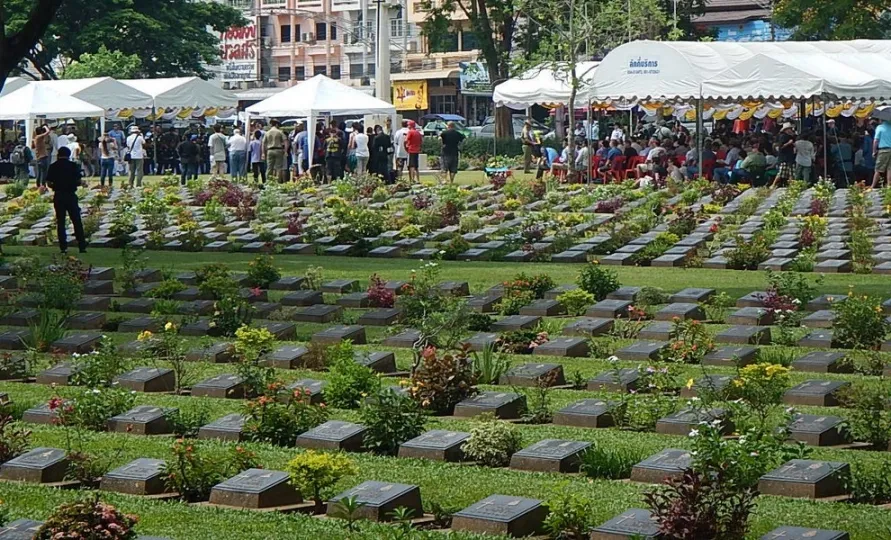
Attractions information
Hellfire Pass Museum
The Hellfire Pass Museum is co-sponsored by the Thai and Australian governments to commemorate the suffering of those Prisoners of War involved in the construction of the railway connecting Thailand and Burma during World War II.
You can walk down into Konyu Cutting itself and along the old track.
Hellfire Pass or Konyu Cutting was a particularly difficult section of the line to build, not only because it was the largest rock cutting on the railway, but also because of its remoteness and the lack of proper construction tools during building.
The Australian, British, Dutch and other allied Prisoners of War were required to work 18 hours a day to complete the cutting and many died from cholera, dysentery, starvation, and exhaustion during the six weeks it took to complete.
A new walkway has recently completed down into the cutting which has made things a lot easier. You can say a quiet word of thanks to the builders on the way down. However, you'll still need decent shoes because the rail bed is stony and the rocks are hard on your feet.
From Konyu Cutting, the walking trail follows the alignment of the original Burma-Thailand railway for approximately four kilometres from Hellfire Pass to beyond Compressor Cutting.
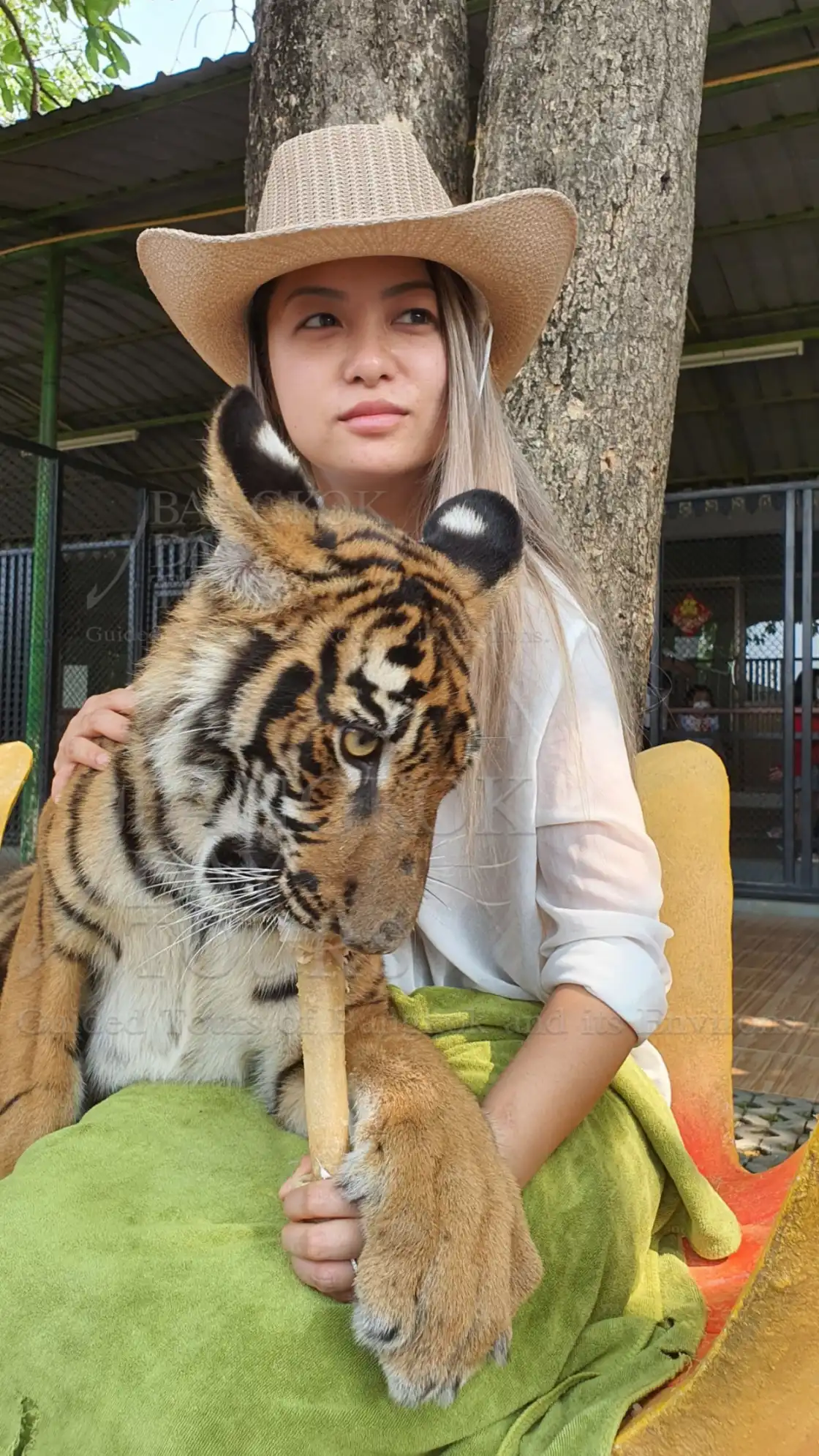
Attractions information
Tiger Temple Classic Afternoon
In Kanchanaburi Province there is a forest temple, founded in 1994, which has become a sanctuary for numerous wild animals including many tigers.
While it is more commonly known as The Tiger Temple, its Thai name is Wat Pha Luang Ta Bua Yannasampanno.
The abbot, Phra Acharn Phusit, has been caring for abandoned tigers since 1999. The mother of the first cub he took in had been killed by poachers. The first tiger cub died from its injuries, but a few weeks later two more tiger cubs were rescued from poachers and brought to the temple.
Word soon spread and more abandoned or injured tigers were brought to the temple. By 2005 there were 17 tigers at the temple. Seven were orphans rescued from the wild and ten have been born and bred here at the temple.
The monastery is situated adjacent to Burma. Protected areas and national parks along the Thai-Burma border are believed to contain the largest surviving populations of tigers in Thailand.
Unfortunately, while these areas are protected, poaching still occurs. A poacher can earn several years of a farmer's salary for killing a tiger, so the profit is well worth the risk. After the mother tiger is killed the cubs are taken as a bonus, or left to fend for themselves in the jungle and if found are left here.
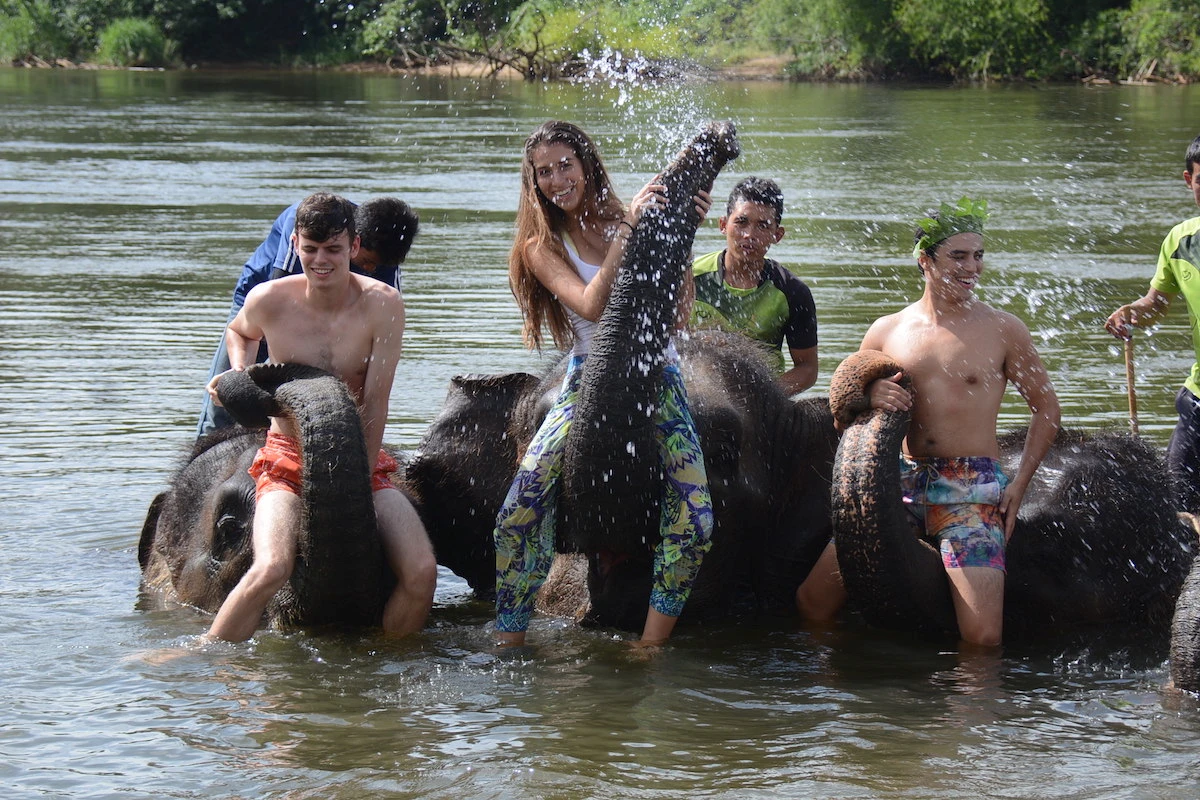
Attractions information
Ride & Bathe Elephants
In Thailand, elephants are the most revered of all animals and still play an active part within Thai society and culture.
In the past they have been used at the forefront of battles and in more recent times to assist in the logging trade. Now, visitors have the opportunity to ride and bathe them.
Despite their vast size, elephants are remarkably agile and are particularly adept at negotiating the narrow tracks in the forest. It's a little nerve wracking, especially when they are going downhill and so make sure you hold on tight.
They often pause along the way, bending far out to pluck some tasty morsel, oblivious to you perched high on their back.
The mahout will jump off during your trek and invite you to slide down onto the elephant's neck and take control. Be warned that their hair is prickly so shorts are not the best attire for this experience.
And also you will be able to bathe the elephants in the waters of the local river. You'll get wet, so don't forget your swimmers. We'll provide the life jackets for you if you want.
Important Information
Not every tour includes bathing the elephants. Please check the Tour Programme.

Attractions information
Kanchanaburi Province
Kanchanaburi Province which borders Myanmar (Burma) to the north-west is the third largest Thailand's of seventy six provinces.
It is located 130 km west of Bangkok and has a population of about 735,000 of which 54,000 live in Kanchanaburi town itself. This is a most picturesque part of Thailand.
Kanchanaburi town was originally established by King Rama I as a first line of defence against the Burmese, who might use the old invasion route through the Three Pagodas Pass on the Thai-Burma border.
The magnificent landscape & charming beauty of Kanchanaburi have resulted in major tourist attractions including the well-known Erawan Waterfalls, caves which were once inhabited by Neolithic man, pristine national parks, tranquil rivers, virgin forests, and reservoir.
Together, they offer an intriguing experience whether you are visiting for the first-time or returning for another visit.
Whatever your personal interest: fishing, rafting, canoeing, mountain biking, bird-watching, star-gazing, golfing, elephants, tigers, jungle trekking or even living on bamboo rafts, Kanchanaburi takes pride in offering them all.
Local residents of Kanchanaburi are engaged in agricultural activities as this is one of the most fertile provinces. Most of the locals are of Thai ancestry with notable Mon and Karen minorities.
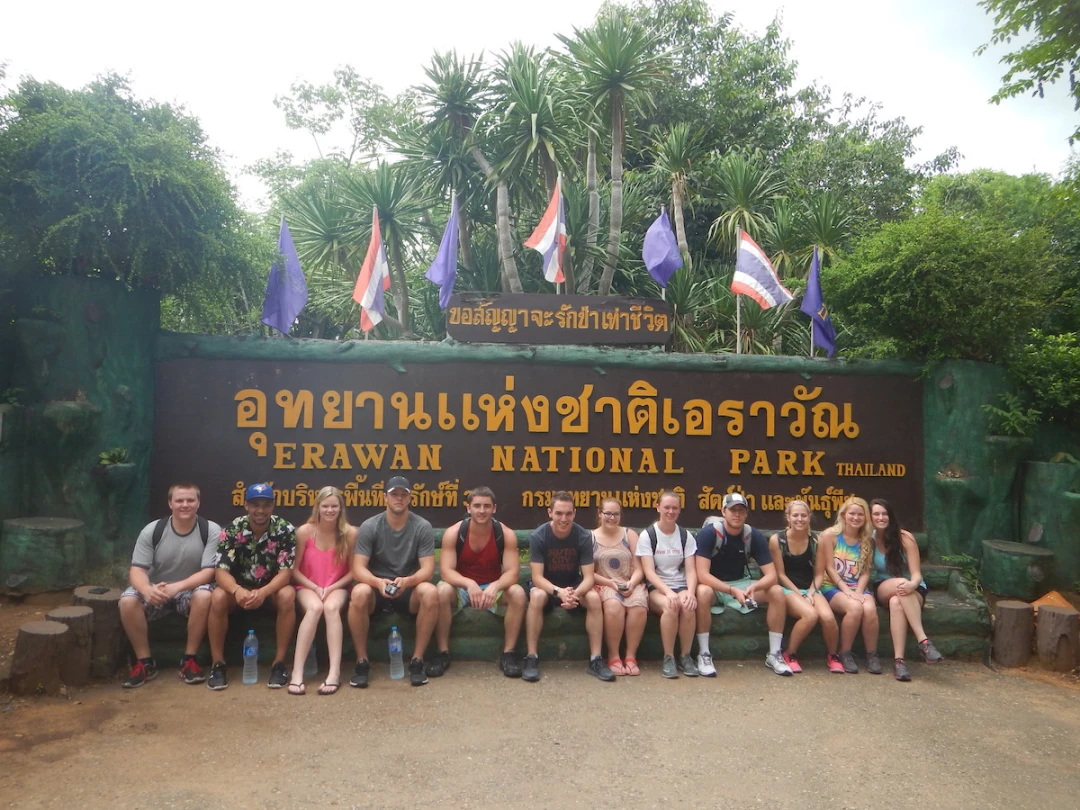
Attractions information
Erawan National Park
Erawan National Park is 550 sq. km. of deciduous forest with high mountains and valleys, located in Kanchanaburi Province. The mountains protect the park from the eastern monsoon. Its major attraction is the Erawan Falls, a magnificent seven-tiered waterfall which you can climb if you feel inclined.
Erawan National Park is in the Tenasserim Mountain Range and is one of the finest natural attractions in the country. The park is best known for its seven-tiered waterfall topped by a rock formation shaped like a three-headed elephant. From its crest, clear water tumbles 1,500 meters down steep-sided cliffs in a series of cascades to rock pools shaded by dense foliage.
The park is open all year although the Rainy Season from May to October is not the best time to visit as there are frequent storms throughout that period. The Cool Season runs from November to January and this is a much more pleasant time to visit. February to April is the Hot Season and temperatures get quite high, but you have the pools at each level to cool off in!
The park contains five different wildlife habitats for mammals, reptiles, amphibians, birds and freshwater fauna. There are elephants, tigers, sambar deer, wild boar, white-handed gibbon, langur, Siamese hare, red flying squirrels and king cobras to be found in the park.
Provincial Thailand Four Day Tour (Code:4102)
Pick a day and people
THB 84,000.00
THB 87,000.00
THB 98,600.00
THB 119,700.00
THB 142,000.00
THB 155,000.00
THB 174,100.00
THB 195,000.00
THB 212,400.00
THB 284,000.00
THB 297,000.00
THB 310,000.00
This tour is not designed for cruise ship passengers. Exclusive cruise ship tours are available from Klong Toey Port and Laem Chabang Port.
If you have been to Bangkok before and now you want to see something different, then this tour is perfect for you. It provides a more relaxed look at some of Bangkok's neighbouring provinces and includes a high standard of accommodation not normally associated with this kind of tour.
Do you want your tailor-made tour?
A tailor-made tour is the best kind of independent travel itinerary, designed and arranged just for you and your needs.
All events and activities are part of your very personal, privately guided tour.
Just ask us and we will be happy to make your tour an unforgettable experience. We have been doing this for 25 years and the quality of tailor made tours has never changed.
Why is a private tour a better choice?
With a private tour, you have the freedom to choose what you want to do and when you want to do it. There is much more room for flexibility and changes to your itinerary at every step of the way because you don't have to consider the needs of other travelers. The flexibility and freedom to make the most of your time is the reason why so many people choose to take a private tour rather than a group tour.Tour Programme
12:00 - Day 1 Departs
12:00 - Pickup from Airport or Hotel
Exact time of pickup will depend on when you arrive in Bangkok. However, many flights arrive mid-morning so we'll start from midday.
14:30 - Arrive at Ampawa Village
Ampawa is only a couple of hours from Bangkok and we'll go directly to your luxury accommodation. Read More >
15:00 - Benjarong Porcelain
We'll visit one of the original places where artists produce the famous Benjarong porcelain. You'll be amazed at the artistic skill portrayed here.Read More >
16:00 - Traditional Thai Massage
One of the pleasures of Thailand is to be pampered with a Thai massage. Lay back and enjoy the experience.Read More >
18:00 - Dinner at Local Thai Restaurant
Enjoy the variety and freshness of local Thai cuisine before taking the boat trip to see the fireflies.
19:00 - Fireflies Boat Trip
The highlight of any trip to Ampawa is the light show which nature provides every evening along the banks of the Mae Klong River, courtesy of the myriad fireflies searching for a mate. Read More >
07:00 - Day 2 Departs
07:00 - Depart for Ratchaburi Province
We'll leave nice and early so we can stop at the morning floating market on the way. If you want to give food to the monks on their morning alms round, we'll wake you about 05:30!
08:00 - Floating Market Damnoen Saduak
This is the original floating market and it opens every day at day break. You'll be there before the tourist buses arrive from Bangkok and will be able to enjoy the sights and sounds of a busy market place. Great snacks can be bought here.Read More >
10:30 - Ratchaburi Ceramics Factory
Ratchaburi boasts the best clay in Thailand and is therefore the centre of the ceramic business for the whole country. You'll be able to watch artisans at work creating both traditional and contemporary ceramics. Read More >
12:00 - Lunch in a Local Thai Restaurant
Thai people love to eat and there are restaurants everywhere, so we'll stop along the way for some nutritious and delicious lunch.
15:00 - Bridge over River Kwai Kanchanaburi
First stop in Kanchanaburi will be at the famous Bridge over the River Kwai. You'll have time for a wander across the bridge but please be careful as there are no safety rails.Read More >
16:00 - Walk along 'Death Railway'
We'll take a walk along the track on the Wang Pho Viaduct so you can see the most dramatic part of this rail journey which is ranked in the top ten in the world. Read More >
17:30 - Check in to Hintok River Camp
Hintok River Camp at Hellfire Pass is a safari tented camp stunningly located on a historical piece of land upon the pinnacle of Hintok mountain where the historical river Kwai runs through.Read More >
19:00 - Dinner at your Leisure
Time to relax and enjoy the tranquility of this unique setting. When you're ready come on down for dinner.
08:30 - Day 3 Departs
08:30 - Hellfire Pass
After breakfast we'll take to short trip up to Hellfire Pass where you can look through the museum and walk down into Konyu cutting if you feel inclined. Otherwise, enjoy the view from the viewing platform adjacent to the museum.Read More >
11:30 - Lunch in a Local Thai Restaurant.
Now that you've built up an appetite, you'll be ready for lunch.
12:30 - Tiger Temple Wat Pha Luang
The afternoon program provides opportunity to see tiger cubs, young tigers and full-grown adults frolicking in the waterfall and bathing in the canyon pool.Read More >
15:00 - Ride & Bathe Elephants
It's only a short drive from the Tiger Temple to the Elephant Camp, where you can experience the mystique of riding your own elephant through the jungle and then taking it into the river for it's afternoon shampoo and scrub. Read More >
17:30 - Check in to Resort in Kanchanaburi Town
Tonight we'll stay in the town, so once you've had a shower you can relax beside the pool until you're ready for dinner.Read More >
08:00 - Day 4 Departs
08:00 - Erawan National Park
One of the most beautiful places in Kanchanaburi Province is the Erawan National Park and we'll spend most of the day here. Read More >
15:00 - Depart for Bangkok
All good things must come to an end, so sit back and relax while your driver returns you to your hotel in Bangkok.
17:30 - Arrive at your Hotel in Bangkok
You can expect to be back at your hotel around 5:30 in the afternoon depending on the traffic. If you have and place to catch or ship to board we will make sure you are back in time!
Important Information
At the Tiger Temple, women must cover their shoulders and knees. Tank tops, short skirts, shorts, shawls and scarves are not permitted. Tights cannot be worn as an outer garment. Also, bright colours like red, orange and pink are not allowed.




